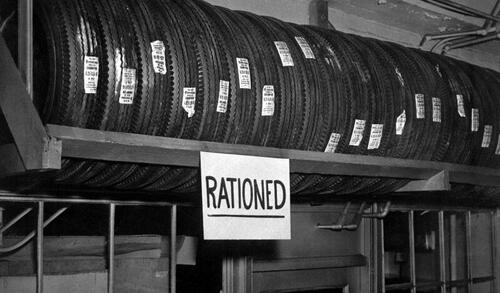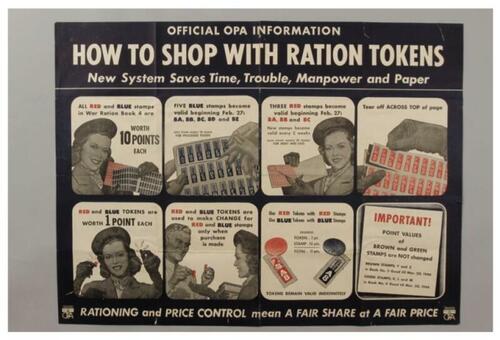Grocery Rationing Within Four Years
Authored by Jeffrey Tucker via The Brownstone Institute,
There is a lack of public comment and debate about Kamala Harris’s call for price controls on groceries and rents, the most stunning and frightening policy proposal made in my lifetime.
Immediately, of course, people will reply that she is not for price controls as such. It is only a limit on “gouging” (which she variously calls “gauging”) on grocery prices. As for rents, it’s only for larger-scale corporations with many units.
This is nonsense. If there really are national price-gouging police running around, every single seller of groceries, from small convenience stores to farmers’ markets to chain stores, will be vulnerable. No one wants the investigation so they will comply with de facto controls. No one knows for sure what gouging is.
Don Boudreaux is correct:
“A government that threatens to punish merchants for selling at nominal prices higher than deemed appropriate by government clearly intends to control prices. It’s no surprise, therefore, that economists routinely analyze prohibitions against so-called ‘price gouging’ using exactly the same tools they use to analyze other forms of price controls.”
As for rental units, the only result will be fewer amenities, new charges, new fees for what used to be free, less service, and a dramatically reduced incentive to build new units. That will only lead to a pretext for more subsidies, more public housing, and more government provision generally. We have experience with that and it is not good.
The next step is nationalizing housing and rationing of groceries because there will be ever fewer available.
The more the betting odds favor Kamala, the stronger the incentive to raise prices as high as possible now in anticipation of price controls come next year. That will provide even more seeming evidence for the need for more controls and a genuine crackdown.
Price controls lead to shortages of anything they touch, especially in inflationary times. With the Federal Reserve seemingly on the verge of cutting rates for no good reason – rates are very low in real terms by any historical standard – we might see wave two of inflation later next year.
Here are real interest rates historically considered as they stand. Do you see a case here for lowering them?
Next time, however, merchants will not be in a position to respond rationally. Instead, they will confront federal price investigators and prosecutors.
Kamala is wrong that this will be the “first-ever” ban on price gouging. We had that in World War II, along with rationing tickets on meat, animal fats, foil, sugar, flour, foil, coffee, and more. It was a time of extreme austerity, and people put up with it because they believed it was saving resources for the war effort. It was enforced the same as we saw with covid lockdowns: a huge network enlisting state and local institutions, media, and private zealots ready to rat out the rebels.
Franklin Roosevelt issued Executive Order 8875 on August 28, 1941. It claimed broad powers to manage all production and consumption in the US. On January 30, 1942, the Emergency Price Control Act granted the Office of Price Administration (OPA) the authority to set price limits and ration food and other commodities. Products were added as shortages intensified.
And yes, all of this was heavily enforced.
In case you are doing the math, that’s a $200,000 fine today for noncompliance. In other words, this was very serious and highly coercive.
Technology limited enforcement, however, and black markets sprung up everywhere. The so-called Meatleggers were the most famous and most demonized by government propaganda.
What happens when the government restricts meat consumption?
During World War II, food rationing led to significant changes in consumption habits in the United States.
Adults and children over 12 were limited to 2 lbs of meat per week, which was monitored through rationing… pic.twitter.com/goCU1FGMnD
— Meat Head (@markeatsmeat) February 20, 2024
In a nation with more agriculture in demographic proximity, people relied on local farmers and various methods of bartering goods and services.
Years went by and somehow people got through it but production for civilian purposes came to a near standstill. The GDP for the period looked like growth but the reality was a continuation and intensification of the Great Depression that began more than a decade earlier.
There are fewer people alive now that recall these days but I’ve known some. They adopted habits of extreme conservation. I once had a neighbor who simply could not bear to throw away tin-foil pie pans because she had lived through rationing. After she died, her kids discovered her vast collection and it shocked them. She was not crazy, just traumatized.
How would such a thing transpire today?
Look at the program SNAP, the new name for food stamps. For those who qualify, the money goes into a special account managed by the federal government. The recipient is sent an EBT (Electronic Benefits Transfer) card, which is used like a credit card in stores. It costs taxpayers some $114 billion a year, and works out as a huge subsidy to Big Agriculture, which is why the program is administered by the Department of Agriculture.
Transitioning that program to the general population would not be difficult. It would be a simple matter of expansion of eligibility. As shortages grow, so too could the program until the entire population would be on it and it would be mandatory. It could also be converted into a mobile app instead of a piece of plastic as a fraud-prevention measure. With everyone carrying cell phones, this would be an easy step.
And where could people spend the money? Only at participating institutions. Would non-participation institutions be entitled to sell food, for example, at local farmers’ co-ops? Maybe at first but that’s before the media demonization campaigns come along to decry the rich who are eating more than their fair share and the sellers who are exploiting the national emergency.
You can see how this all unfolds, and none of it is implausible. Only a few years ago, governments around the country canceled gatherings for religious holidays, limited the numbers of people who could gather in homes, and banned public weddings and funerals. If they can do that, they can do anything, including the rationing of all food.
The program that Harris has proposed is not like other matters that she has flip-flopped on. She is serious and repeats it. She spoke about it even during the debate with Trump but there was no followup or critique of the scheme offered. Nor does such a crazy plan require some legislation and a vote by Congress. It could come in the form of an executive order. Yes, it would be tested by the Supreme Court but, if recent history holds, the program would be long in effect before the Court weighed in. Nor is it clear how it would rule.
The Supreme Court in 1942 heard the case of Albert Yakus, a Boston-based meat seller who was criminally prosecuted for violating the wholesale beef price ceiling. In Yakus vs. United States, the Supreme Court ruled for the government and against the meat-selling criminal. That’s the existing precedent.
Nor does all this have to unfold immediately following the inauguration. It can happen as matters become ever worse following anti-gouging edicts and when inflation worsens. After all, a presidency that believes in central planning and forced economic austerity would last a full four years, and the coercion could grow month after month until we have comprehensively enforced deprivation by the end, and no one remembers what it was like to buy groceries at market prices with their own money.
I wish I could say that this is an outlandish and fear-mongering warning. It is not. It is a very realistic scenario based on repeated statements and promises plus the recent history of government management of the population. There is likely another wave of inflation coming. This time it will meet with a promise to use every coercive power of government to prevent increases in prices on groceries and rents.
What if voters actually understood this? What then?
Keep in mind the main legacy of the Covid years: governments learned the fullness of what they could do under the right circumstances. That’s the worst possible lesson but that is what has stuck. The implications for the future are grim.
Tyler Durden
Tue, 09/17/2024 – 07:20
via ZeroHedge News https://ift.tt/jmzSHBA Tyler Durden



